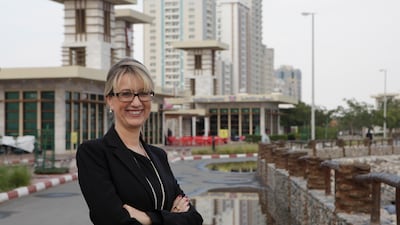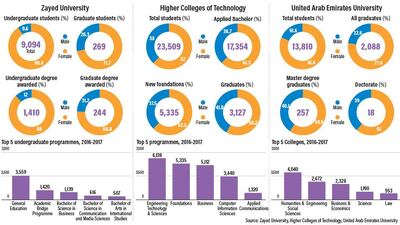At two of the nation’s three federal institutions of higher learning, women comprise between 80 and 90 per cent of the student population, an analysis by The National has found.
Of the 9,363 undergraduate and graduate students that registered at Zayed University last autumn, 89.9 per cent were women.
At the United Arab Emirates University, the country’s oldest, the overall student population has grown from 501 in its inaugural year in 1977 to 13,810 in 2016. While men made up 62 per cent of the first batch of students, they comprised only 18 per cent of the student population on campus last academic year.
The male-female student ratio is most balanced at the Higher Colleges of Technology, the country’s largest public federal institution of higher learning. Last year, women made up 62 per cent of the student body at HCT.
“Enrolling and retaining national male students has been a main challenge for UAEU and other federal universities,” according to a report by UAEU about graduation and attrition rates. “Given the employment and higher education opportunities available to national students after secondary education, it has been difficult to attract and retain this segment of students. Comprehensive and co-ordinated approaches at the national level need to be taken to address this challenge.”
When it comes to graduation rates, the picture improves, but not by much. Of the 1,410 students who earned an undergraduate degree at Zayed University in 2015-2016, 88 per cent were women. At UAEU, women made up 77 per cent of the 2,088 graduates in the same year. HCT had the highest per cent of men who graduated in 2015-2016: 41 per cent or 1,306 male graduates.
______________
Read more:
Universities aim to increase Emirati interest teaching programmes
New apprenticeship programme offers Emirati graduates media training at international companies
______________
HCT Vice Chancellor Dr Abdullatif Al Shamsi said the college’s flexible day and evening scheduling, multiple locations and varied programmes have helped to attract and retain students. The college is made up of 17 campuses across the UAE, whereas UAEU is based in Al Ain and Zayed University has a campus in the capital and another in Dubai.
“It is more convenient for them to attend higher education somewhere close to their home, that’s an advantage,” said Dr Al Shamsi. “But more importantly, it’s the type of education we deliver. This generation of students, they are more interested in a different type of education and pedagogy than the traditional approach. We use a technical education, we use a lot of hands-on practice, we use a lot of technology, we use a lot of simulations, apps in our pedagogy of teaching that excites students and gets them more interested.”
The college recently adopted a ‘no Emirati left behind’ philosophy and slogan to send the message that students of all levels are welcome.
“Even if you are not a high achiever, we have something for you,” said Dr Al Shamsi. Students may enrol for one-year certificate programme, a two- or three-year diploma or a four-year bachelor's degree.
“But the key thing that we guarantee also, it’s not just a certificate and a diploma, we guarantee also proper job employment for those students because all of our programmes are coupled with a professional certification where there is a demand in the market to hire those graduates,” said Dr Al Shamsi.
Dr Natasha Ridge, executive director of the Sheikh Saud bin Saqr Al Qasimi Foundation for Policy Research and author of "Education and the Reverse Gender Divide in the Gulf States," said it is no surprise HCT has been successful in recruiting more male students compared to the other federal universities.
“For men, there are a lot of classes that are held in the evening and after work,” said Dr Ridge. “A lot of men who attend HCT are actually returning or they have families, so they are able to balance work and study at HCT. They have more options. Also, HCT has more technical degrees that men will be attracted to, more applied degrees, and lower entry requirements.”
Emirati high school graduates in the advanced stream need to achieve an average grade of 60 per cent to enter HCT’s non-engineering technology programmes. Those in the general stream, need to earn an average of 70 per cent. At UAE, the minimum entry requirement for Emirati high school graduates is 75 per cent average for general education, and 85 per cent if applying to the College of Medicine and Health Sciences.
At Zayed University, nationals need to earn a minimum average of 70 per cent in grade 12 to enter.
The gender imbalance at Zayed University is not entirely surprising given its history, said Dr Ridge. The university was founded in 1998 as a single-sex university to give women more opportunities to study closer to me. At the time, the UAEU in Al Ain was the country’s only public federal university.
“The idea was to provide the women an alternative so that they didn’t have to travel to Al Ain and stay in dorms,” said Prof Reyadh Al Mehaideb, Zayed University’s vice-president.
But as demand for higher education grew among both young men and women, Zayed University began admitting men in 2010. Although men no longer share the Dubai campus with women — it became single-sex in 2014 — there are plans underway to build a new all-men’s campus in 2018, said Prof Al Mehaideb.
“Now we are in-between, so when the new campus in Dubai opens, we’ll have both men and women in Dubai and Abu Dhabi,” said Prof Al Mehaideb. But, he acknowledges that challenges remain in recruiting and retaining male Emirati students. “It has been for a decade like this, that we have more women than men in higher education throughout the country.”
A number of reasons explain the long-standing gender imbalance, beginning with the public high school graduation rates, said Prof Al Mehaideb.
“By the time the students graduate from high school, it is almost 60-40 girls to boys,” he said. Male high school graduates are also more likely to enter the workforce right after school, join military or police academies or travel abroad for education, said Prof Al Mehaideb.
“Usually it’s 90 to 10 (per cent) the other way, men to women,” he said of international study opportunities. “Women don’t like to study overseas, they like to study in the country, while some prefer would like to go overseas.”
The Ministry of Education said there are between 1,000 and 1,200 Emiratis men and women studying overseas, including 300 who earned government scholarships.
But, as is the case elsewhere in the world, participation in higher education doesn’t necessarily equate participation in the labour force. In the Abu Dhabi region, 36.6 per cent of Emirati women worked last year, compared to 65.2 per cent for Emirati men, according to the Statistic Centre Abu Dhabi Statistical Yearbook 2017. By comparison, 68.2 per cent of non-citizen women and 94.8 per cent of non-citizen men participated in the labour force.
Dr Ridge said gender imbalance at institutions of higher learning is not exclusive to the Emirates, but it is cause for concern.
“This is a phenomenon happening all around the world, (though) not yet to the degree we are seeing at some universities in the UAE,” said Dr Ridge. “So, long term, is it a problem? Yes, I think it is. It’s a problem for human development. The UAE needs to have both men and women who are well educated and able to contribute to the national development of the country. They need them to fill leadership positions and to fill positions across society. So, of course, if only half your population is well educated, that’s a problem. It’s also a problem at a social level. We are seeing a decline in marriage rates, women like to marry similarly educated men. So it’s getting to be a growing challenge for women to find a man who is similarly educated.”


